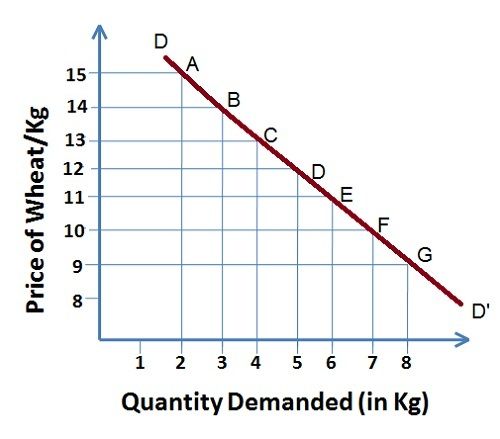Definition: The Law of Demand asserts that there is an inverse relationship between the price, and the quantity demanded, such as when the price increases the demand for the commodity decreases and when the price decreases the demand for the commodity increases, other things remaining unchanged.
In the definition, the “other things” are the factors that influence the demand such as consumer’s income, price of related goods, consumer’s tastes and preferences, advertisement, etc. The law of demand can be further illustrated by the Demand Schedule and the Demand Curve.
Demand Schedule: The demand schedule is a tabular presentation of series of prices arranged in some chronological order, i.e. either in ascending or descending order along with their corresponding quantities which the consumers are willing to purchase per unit of time. A hypothetical daily demand schedule for the commodity (Wheat) is given below:
| Price of Wheat/Kg | Wheat Demanded by Family/Day (In Kg) | Price Quantity Combinations |
|---|---|---|
| 15 | 2 | A |
| 14 | 3 | B |
| 13 | 4 | C |
| 12 | 5 | D |
| 11 | 6 | E |
| 10 | 7 | F |
| 9 | 8 | G |
The table clearly illustrates the law of demand, i.e. the demand for wheat increases as its price decreases. For example, at price Rs 14/kg only 3 kg of wheat is demanded, but as the price decreases to Rs 13/kg the quantity demanded increased to 4 kg.
Demand Curve: Demand curve is formed when the demand and price data in the demand schedule is plotted on a graph. Thus, the demand curve is the graphical representation of the demand schedule. The above demand schedule is represented graphically in the figure below:
The DD’ is the demand curve that depicts the law of demand. The demand curve is downward sloping towards the right, which shows that as the price of the wheat decreases the quantity demanded increases.
While plotting the demand curve the following assumptions are to be taken into the consideration:
- The consumer’s tastes and preferences remain unchanged.
- The discontinuous change is ignored, and therefore the price-demand relationship is considered continuous.
- The consumer’s income remains same.
- No individual can influence the price.
- The price of the related goods remains the same.
Thus, it is clear from the above explanation that the law of demand strictly follows an inverse relationship between the price of the product and its quantity demanded, i.e. the quantity decreases with the increase in the price and vice-versa.


Hina says
Very nice … this site is very beneficial for all type of information according to business and economics. And the way of explaining is very easy to understand. Thank you so much
Mohit says
I found all the info very nice and helpful thank you so much
Sanjana Newar says
Thank you for this